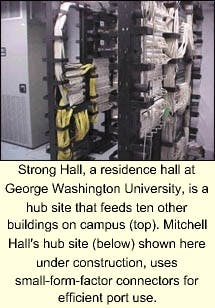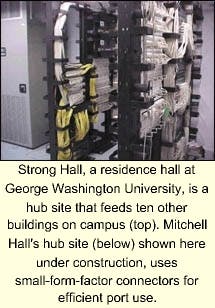George Washington University fiber facelift brings horizontal runs to a single location.
Ryan Cliche
George Washington University (GWU) in Washington, D.C. has found that creating a faster network within its older buildings can be achieved through a fiber-based collapsed bone installation.
Before the migration to a switched network, GWU's on- campus communications architecture consisted of five distinct networks: two hard-wired, one wireless, one telephone, and one television. It was a collection of shared-media Ethernet and token ring LANs, plus Integrated Services Digital Network (ISDN) technology, all connected to a Fiber Distributed Data Interface (FDDI) token ring backbone.
Not surprisingly, the largely copper-based network lacked unity and standards in its installation throughout the 180 wiring closets on campus. Additionally, different connection types had produced maintenance problems and an inability to upgrade.
Installing an entirely new network, however, was not an easy task. Many of the school's 81 buildings are old or historic and needed to be retrofitted. There were no riser spaces, closets, or equipment rooms to provide room for new wiring and equipment. So, GWU chose to implement fiber-optic splicing, which helped consolidate network equipment and wiring.
All-in-one location
The new fiber-based system lets GWU collapse horizontal runs to locations called hub sites. Ron Schreiber, RCDD, the college's manager of special projects, information systems and services, says historic Strong Hall was one of the more difficult hub sites to construct. Special consideration had to be given to the hallway of the residence hall so that the "look" was preserved. Schreiber says his solution for a raceway was to "add another piece of wood molding that fit in with the rest of the ceiling molding."
After installing the cable, Schreiber said, the molding raceway blended in with the interior of the building, maintaining the older building's architectural integrity even while upgrading its network to the 21st century.
Once the buildings were suited to house the new network, installers used splicing to create a collapsed backbone system that connected a direct path from each outlet to one of 11 hub sites located throughout the campus. Explaining how splicing the horizontal fiber directly to a high-count fiber-optic cable improved connections, Schreiber said, "By doing this [splicing], there would be no need for intermediate terminations or patch cables."
With the retrofit, the fiber runs uninterrupted from the outlet to the hub site, where the equipment for these connections is located. Splicing creates the direct path to the hub sites needed for a fiber-to-the-desk system to support voice, computing, two-way video conferencing, and high-performance research applications. The elimination of intermediate patching translates to lower construction costs, since there is no longer a need for terminating closets on each floor or equipment rooms in each building.
The collapsed backbone installation has resulted in operational cost reduction. Instead of having to maintain 180 equipment closets, technicians will now only have to monitor 11 hub sites. The new switched network also offers increased reliability. On the old shared system, one user could conceivably bring the entire network down.
GWU's information systems and services department sets standards and controls connections for all faculty, staff, and students. For example, each student or staff member receives a switched 10-Mbit/sec Ethernet connection that runs over fiber, with a media converter at the station location. Each full-time faculty member receives an Asynchronous Transfer Mode (ATM) connection to his or her office.
Simple connections
Deploying connections is also simpler with the new infrastructure in place. For example, a technician can migrate a switched 10-Mbit/sec Ethernet connection to an ATM connection by simply moving a patch cord within the hub site. The technician only needs to visit the hub site to patch the port to the jack, and then patch the station to the outlet at the user's location.
Schreiber says a hub site in Mitchell Hall serves that residence hall as well as another residence hall next to it. Combined, the two buildings house more than 1,500 fiber connections. "By collapsing all fiber connections back to the Mitchell Hall hub site, we eliminated all active closets," Schreiber says. "Only the hub site has electronic equipment in it."
Schreiber can monitor the hub site within Mitchell Hall from the campus' support building, because the two hub sites are linked. Mitchell is also linked to a combined residence and academic hall that has more than 2,600 fiber drops-including one at every seat in each classroom and auditorium.
Mitchell had a fiber infrastructure before the retrofit, but the fibers were terminated to ST-style connectors. During the upgrade, however, GWU switched to 3M's (Austin, TX) VF45 fiber-optic interface on the switches. In addition to the low cost when compared to ST-style connectors, the VF45's small form factor allowed greater density and faster termination. Additionally, thanks to the efforts to collapse all connections, "port utilization was dramatically increased, to an average of 98%," says Schreiber. "Since all equipment is located in the hub site, unused ports are limited to the capacity of the blades in the switch."
The connector interface allows faster termination because the installer terminates two connectors in the time normally taken to terminate one. The reduced interface size also translates to greater density and a 50% increase-from 16 to 24 ports per blade-on Ethernet switches.
"The backbone cables placed to each building were sized so there would be spare fiber for additional connections in the future," said Schreiber.
GWU hopes this basic infrastructure will last 15 to 20 years, but the college also aims to gain from the higher bandwidth. In the near future, Schreiber says he wants to include "voice and computer-telephony integration" and "the integration of an IP phone to the PBX, with all of the features associated with the PBX."

